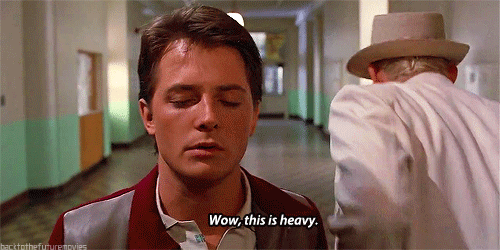News•October 21, 2015
Back to the Future Day, in Climate Trends
The future is now, at least when it comes to the film Back to the Future. Today, Oct. 21, 2015, is Back to the Future Day, when Marty McFly and Doc Brown arrived in the future in the classic film's 1989 sequel.
Were he truly arriving now, the first thing Marty might notice are iPhones and electric cars (but no hoverboards — yet!). But there have been other dramatic changes in the intervening decades, including to something the movie didn’t dwell on — the climate.

With all the running around, Marty might not have noticed shifts in the climate as he jumped through time, but there have definitely been big changes. If you toss in the original movie and the third installment, he spent time in 1885, 1955, 1985 and 2015. Over that period, temperatures, sea level and carbon dioxide levels have all risen steadily.
Globally, the average annual temperature has risen about 1.8°F since 1885 until the present, and this year is likely to be the hottest year on record. Much of that warming has come since 1985. Heck, the last time the world experienced a cooler than normal month was February 1985.
California, where Back to the Future is set in the fictional town of Hill Valley, has also seen rising temperatures, including last year, which was a record-breaking scorcher. So much for Marty needing that orange puffer vest in 2015.
In the same span of time, sea level and carbon dioxide (CO2) have been rising. Sea levels have risen about 8 inches with most of that coming after 1955. The level of atmospheric CO2 wasn’t even being measured regularly in 1955, though scientists have other ways of getting estimates for that date and much later. But if we start at 1958, when continuous measurements began, the amount of CO2 in the atmosphere has increased from 315 ppm to 400 ppm.

What if Back to the Future had a fourth installment with Marty jumping forward 30 years from today? If global emissions continue on their current trajectory (nevermind if we add flying cars to the mix), the impacts of climate change would be even more evident and threatening than Griff Tannen’s gang.
By mid-century, the global temperature is projected to rise another 1.4°F. Sea level will continue to rise as well; the Intergovernmental Panel on Climate Change (IPCC) projects global sea level could rise another foot by 2050.
These changes could cause problems for coastal communities, ecosystems and, well, the whole planet that will make the lack of hoverboards — and continued Cubs World Series drought — seem like small potatoes in comparison.
You May Also Like:
El Niño Keeps Antarctic Sea Ice From Another Record Max
This is the First Full Earth Image From a Weather Satellite
A New Blue Marble Every Day, Courtesy of NASA
Study Sees Ecological Risks as Solar Expands
